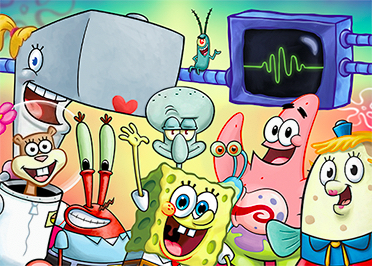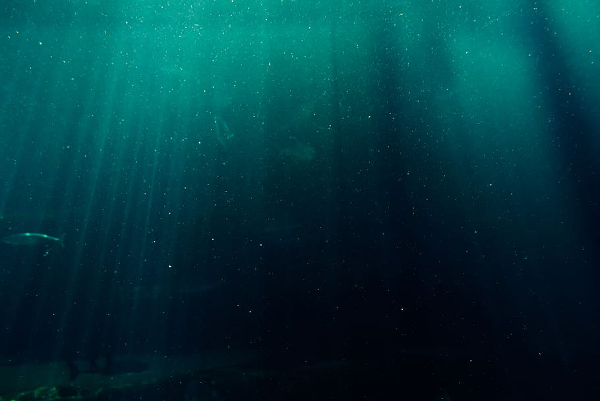What’s SpongeBob Squarepants’ claim to fame besides being an animated cheese-looking, blockhead sponge under-the-sea main character of a children’s cartoon with catchy song lyrics?
Apparently, aside from the possible influence on decreased attention span in children, the creators of SpongeBob SquarePants weren’t too far off in their character portrayal of different sea creatures, including the many different invertebrates, including a sea sponge, sea star, octopus, and crab.

In recent years, scientists have become enamored by the learning abilities of various invertebrates, such as octopus, cuttlefish, squid, and crabs. Octopus successfully solve puzzle box tests while cuttlefish can delay their gratification for a preferred food, a task that many great apes struggle to pass. The great mystery is how can these invertebrates solve such cognitively complex tasks without a central brain to process the incoming information?
In a recent review published in the Psychonomic Society’s, Learning and Behavior, Dr. Ken Cheng summarized the available literature on the learning capabilities of the phyla, Cnidaria, which includes jellyfish, box jellies, hydra, corals, and sea anemones (pictured below). Sponges, like SpongeBob, fall into the phyla, Porifera. Although sponges, which do not have nervous systems, have recently been argued to be sentient due to their ability to adapt to changes in their environment by some, little research exists on their potential cognition.

Cheng chose to narrow his review to Cnidaria due to the presence of a neural network or neural net and the lack of available research for the other three phyla, Porifera (sponges), Placozoa (Trichoplax sp), and Ctenophora (comb jellies). One may wonder why an examination of the learning abilities or cognition of brainless animals is of interest. As all good comparative scientists will attest, understanding the limits and capabilities of organisms allows us to trace the evolutionary history of specific traits.
While Cnidaria lack a brain, activities, such as hunting prey, are conducted by coordinating different parts of their neural nets. This coordination of cognitive processes outside a central brain is considered to represent embodied cognition, a topic that is currently being debated in many different philosophical and scientific venues. Using the above definition, Cheng argues that all learning in Cnidaria constitutes embodied cognition.
There are four recognized classes of Cnidaria:
- Anthrozoans (sea anemones & coral)
- Hydrozoans (hydra like Portuguese Man O’ War)
- Scyphozoans (true jellyfish)
- Cubozoans (box jellies)
To explore the question of the most basic aspect of cognition in animals without a central brain, Cheng did a literature search in 2019 and again in 2020 for research investigating non-associative learning and associative learning in Cnidaria.
Non-associative learning includes two phenomena: habituation and sensitization. Habituation is when a stimulus is experienced repeatedly, the initial exposures produce responses, but after enough exposures, responding decreases. Sensitization is the reverse response, instead of decreasing responses, responses increase with multiple exposures.
I often use the following analogy to illustrate these phenomena to my undergraduate students: Think of sharing a room with another individual for the first time, the sniffles and snores that are produced by the new roommate are annoying and disruptive when trying to fall asleep those first few weeks (sensitization). However, over time, you get used to the not-so-new roommate’s bedtime sounds and eventually are able to fall asleep with ease (habituation). That is, until they get a cold and all sniffling and snoring intensifies (sensitization again)! These two forms of learning are considered non-associative because the learner is not linking or connecting two distinct events.
In contrast, associative learning, such as classical conditioning or operant conditioning, depends on the learner connecting two events together as one event is contingent on another. In the case of classical conditioning, the sight of a Portuguese man o’ war on the beach creates a little anxiety and a large walking radius around it after being stung multiple times during a trip to the beach as a child. I linked a man o’ war sting to the sight of a man o’ war on the beach to an expected outcome of pain, which created the anticipatory response of anxiety. Man o war on the beach
In the case of operant conditioning, I was more likely to jump in the pool and swim to the other side after I earned starburst candy for doing so. Today, my reinforcement for swimming comes from the wonderful aquatic wildlife (pictured below) that can be experienced while snorkeling in the safe tropical waters in which box jellies (the most venomous of jellies) and Portuguese man o’ war (the hydrozoan that stings) do not reside.

After multiple searches in the Web of Science involving all kinds of variations of topic terms (e.g., anemone, coral, hydra, box jell*, and jelly fish) combined with learning terms (e.g., conditioning, habituation, sensitization), Cheng discovered some interesting trends.
First, the published literature suggested that box jellies and coral had not been tested for any learning phenomenon. As with all phenomena, the absence of evidence for learning phenomenon may simply be a function of this topic not being studied yet. However, it could also mean that this topic had been studied but no significant findings emerged and not publishable. And finally, it could be that box jellies and coral do not demonstrate these simple forms of learning. More research is needed.
Second, habituation appeared to be present in hydras, jellyfish, and sea anemones. Tested with mechanical stimulation such as repeated streams of water to the oral disk that contracts and relaxes with stimulation or repeated exposure to a type of food, individuals from these three classes of Cnidaria habituated to the various stimuli and reduced their responding rate to the stimuli. However, as pointed out by Cheng, to truly demonstrate habituation, a dishabituation condition must also be tested. In this condition, the animal would return to original response levels if a new stimulus is presented. That is, if a different type of food was presented to the organism, the organism would accept the new food instead of rejecting it. Cheng found evidence of habituation and dishabituation for sea anemones within this feeding context as well as mechanical stimulation with water jets and exposure to other sea anemones (sea anemones aggress towards other sea anemones that come too close).
Third, evidence for sensitization was found for sea anemones with many different stimuli, including electrical or mechanical events to stimulate muscle contractions, chemical stimuli for both muscle contractions and releasing stinging cnidocytes, touches from tentacle of other sea anemone species or starfish arm, and visual presentations of conspecifics. Hydras may have shown suggestive evidence of an escape response to repeated mechanical stimulation but this study was conducted in the early 1900s, had limited information, and has not been replicated. No other cnidarian has been investigated for sensitization.
Fourth, in terms of associative learning, the sea anemones are the stars of the show or at least have the jazz hands! Cheng found no evidence of associative learning paradigms tested for hydras or jellyfish. However, he did find several studies that implemented classical conditioning procedures with success. Electrical stimulation was conditioned with food to lead to mouth opening when electrical stimulation was given for some sea anemones. A similar finding occurred when sea water was used instead of electrical stimulation in a separate study. And in the best demonstration of classical conditioning (because proper control conditions were used during the conditioning process and in the testing process – random presentation of each type of stimulus by itself, shock by itself and light by itself, in addition to the pairings – light followed by a shock), sea anemones learned to close its oral disk when the light was presented after it had been conditioned.
Unfortunately, operant conditioning studies were limited (like the light at the bottom of the ocean depths). The single study discovered in Cheng’s literature search suggested that sea anemones eventually learned to avoid conch after experiencing a punishment (shock) for eating or holding the food. Interestingly, the sea anemones would eat fish meat as food, demonstrating that they could discriminate between the two types of food – conch and fish.

Ultimately, SpongeBob SquarePants should probably be SeaBob AnemoneFins (pants doesn’t really flow with anemone) based on this review of the scientific evidence of the learning abilities in an aquatic phyla that is considered above sponges but still near the bottom of the evolutionary history, intellectual tree.
As Cheng described throughout his paper, uncovering what forms of learning are shared across organisms with different neurobiological makeups and how those neurobiological makeups facilitate the learning would aide our understanding of the evolutionary history of learning and inform the debates on embodied cognition, memory, and perhaps sentience or consciousness. These topics are especially intriguing as we begin to accrue evidence of non-associative learning in single-celled organisms like slime mold or in multi-celled plants like the sensitive plant (Mimosa pudica).
But we must always keep in mind Occam’s razor and remember to approach these topics from the simplest explanation possible and not generalize beyond the evidence. Cnidaria are fairly simple creatures as a whole with some abilities to learn in biologically meaningful contexts with the consequence of continued survival. That’s pretty smart … for a sea anemone.

Featured Psychonomic Society article
Cheng, K. (2021). Learning in Cnidaria: A systematic review. Learning & Behavior, 1-15. https://doi.org/10.3758/s13420-020-00452-3

1 Comment
Nice. Thanks. FWIW, many of these behaviors are actually found in even simpler species. As described my recent book, The First Minds: Caterpillars, Karyotes, and Consciousness (OUP Press), bacteria learn (including both associative, and pattern learning), form stable memories, display valenced perception, communicate with other bacteria both within- and between-species, show a primitive form of altruism, and importantly, are sensitive to anesthetics.
Cell biologist Frantisek Baluska and I have been examining the biomolecular processes that are responsible for these remarkable abilities and have offered several candidates, all of which are modulated by the cell membrane. Let me know if you’d like the references.